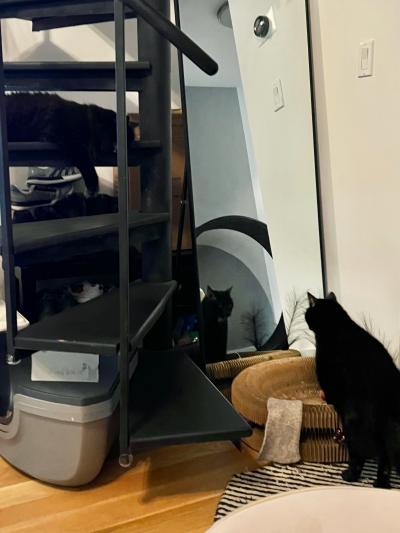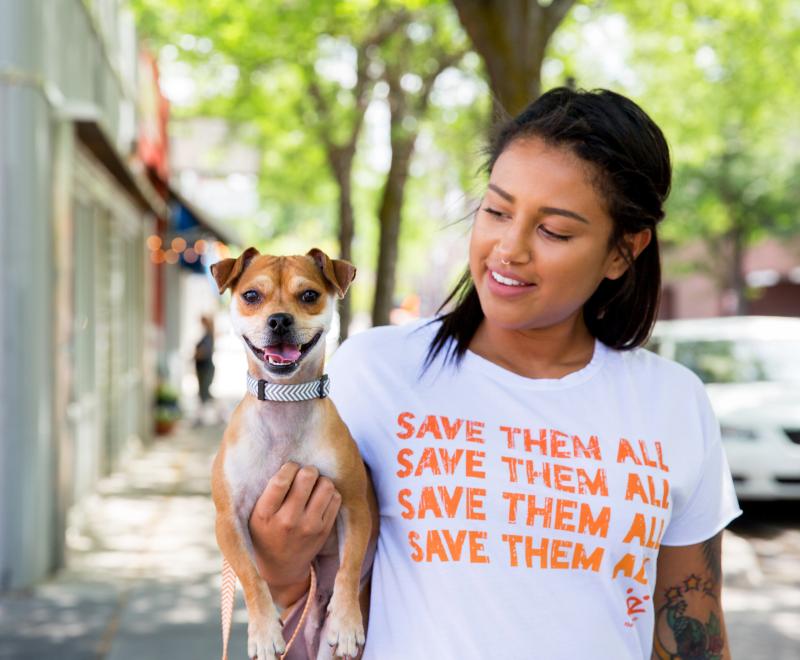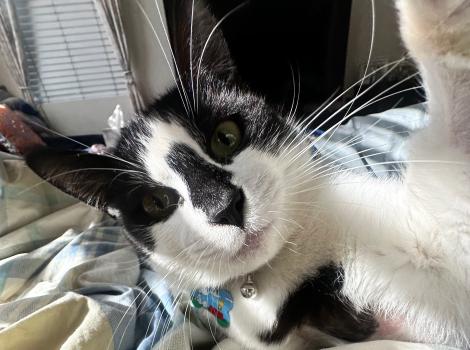Faces of No-Kill: Shy senior cat gets a chance to shine

The Faces of No-Kill series highlights stories about pets who have become a statistic in the best way. These are just a few of the many pets who once slipped into danger; they lost their homes, they had health or behavioral challenges, their families couldn’t care for them, or all the above. But each one of them got assistance, and today they are thriving thanks to an animal shelter program that helped them rather than killed them. Best Friends’ goal is for every animal shelter and every community to reach no-kill by 2025. The story below is just one example of why it’s so important.
It’s hard to get to know a cat when he’s hiding. When potential adopters caught a glimpse of Shane, a shy black senior cat with a dash of white on his neck like a little bow tie, he was curled up in a ball or hunched down in his enclosure at the Best Friends Lifesaving Center in New York City.
Jenna Goldberg, Best Friends Northeast community engagement coordinator, knew two things when she first met 10-year-old Shane. The first: He was a sweet, super shy guy. The second: He needed a person who was interested in adopting an older kitty and who would give him all the time he needed to come out of his shell.
Kittens are easy. They’re playful, adorable, always out front and getting attention. And younger, more social cats who’ll be quicker to adjust to a new home are easy. But finding the person willing to take on the commitment of adopting an older cat who needs space and time — possibly months — to adjust can take time. Jenna knew that, too.
Not every adopter is eager to adopt a cat they may see little of at first — a cat they may not be able to touch, let alone cuddle or scoop up to take to the vet. That’s a kind of unconditional love, as Jenna saw it, and it was what she kept hoping they’d find for Shane.

Seeing a shy cat’s distinguished side
It was during enrichment time, when the cats were out with toys and treats, that Jenna first saw Shane hunting in the middle of the room, very visible for once. His ears were forward, and his body language expressed confidence and happiness. Tail lifted, he sniffed the mats, nosing for the treats tossed here and there. Seeing him looking comfortable in his environment was a surprise — and a good sign.
As he gained confidence, treat hunting remained one of Shane’s gentlemanly pursuits. But there were others, too. Like his attendance at the “Seniors Club.” During enrichment time — as younger cats ran here, jumped there, and generally bounded around — Shane and two other senior cats quietly sat in a group, impervious to the ruckus. They didn’t cuddle. They didn’t crowd. They respectfully sat or lay around together, chill and nonchalant.
[Senior cat is love at first sight]
For Jenna, Shane was a feline George Clooney, a handsome gentleman who had aged well and appreciated the finer things — like food. A treat lover, Shane would eventually allow people to be nearby if they came with a crunchy offering. He remained hesitant when it came to being touched, and it took time for him to be comfortable with people walking near him at all. More withdrawn than fearful, he simply wanted his space.
As the caregivers and volunteers continued to help him come out of his shell, Jenna didn’t lose hope that Shane would be adopted. And then one day, it happened.

Adopter speaks feline’s language
A few years ago, Candace Ma adopted KiKi, a timid, senior, long-haired black cat from Best Friends. It took a year for Candace to build a rapport with KiKi. And when KiKi developed some separation anxiety, Candace decided to look for a companion for her.
She returned to the lifesaving center and decided to walk right past the kittens. She wasn’t looking for a young cat. She was looking for someone more mature, calm, quiet, a little lazy even — someone who would be easygoing enough for KiKi. When she saw Shane lying in the middle of a room, she paused and looked at him. He looked back. It felt, Candace says, like talking.
Candace did not go over to Shane or try to pet him. Instead, she found his bio, and as she read she recognized similarities between his situation and KiKi’s. She came back to see him a couple more times after that initial meeting. And then one day not long after, she walked in, carrier in hand, and declared that she had come to take Shane home.

Shy Shane finds his place
KiKi had given Candace and her husband lots of practice being patient. They knew how to give Shane space and time. KiKi, on the other hand, wasn’t especially happy with the new arrangement at first. Candace kept them separated for about a month to help Shane feel safe and help KiKi warm up to the idea of him.
Candace used food to introduce new spaces in the apartment to Shane. They placed his bowl in the same space as his litter box, and they steadily moved him from one room to another to get familiar with the apartment.
It didn’t take long to discover that his favorite place is the bedroom. There is a small balcony off the room, and it overlooks the top of a tree. Shane loves to watch the birds.
[Sweet senior cat wins the heart of loving adopter]
Though KiKi was initially a bit grumpy and chased after Shane when she could, he remained the gentleman Jenna and the Best Friends caregivers had come to know. He never challenged KiKi or became aggressive. He didn’t try to take over her spaces or toys. He treated KiKi as though she were the queen and he her knight there to serve.
Shane has arthritis that prevents him from climbing to the second floor of the loft apartment, so when KiKi wants time alone she can go there. Just as he enjoyed treat hunting at the lifesaving center, Shane enjoys exploring down on the main level. He picks things to investigate; he pushes open doors. And as he’s become more comfortable in his new space, he’s begun to open up to Candace and her husband.
When Shane first arrived, he would move away if Candace or her husband walked toward him. But now, knowing that they’ll respect his space, he has begun responding to their invitations to play. Encouraged, they’ve made it a routine, bringing toys out to play with him at a distance every morning and evening.
Adding to this progress, KiKi has begun to accept Shane. She hangs out with him on the same square of carpet. They play, both lying down with the toys being tossed to them, too old and distinguished — maybe a little lazy too — to bother with running around. When KiKi sits with Candace and her husband at night, Shane comes around wanting to be near her.
Once Candace had a construction worker come to move a sink so that there would be more litter box space in the bathroom, and both cats hunkered down in the same place in the bedroom together during the work. Candace could see that they were comforting each other. Without KiKi, Candace knows they wouldn’t be able to be this close to Shane this soon.

A gift of amazing companionship
For Jenna, seeing Shane get adopted wasn’t just another heartwarming moment; it was a gift — proof that there is a person for every animal.
“Giving space is a way of loving,” Jenna says. It’s a gift that isn’t just for the animal. That gift comes back to the person, too, who gains the animal’s trust and companionship.
For Candace, adopting is more like finding a roommate than it is an act of ownership, being mindful of another’s space, needs, and personality. KiKi and Shane are the grandma and grandpa of her apartment. They bicker from time to time when KiKi hisses and Shane talks back. But more often they live together peacefully and happily with Candace and her husband, who enjoy their company.

Let's make every shelter and every community no-kill by 2025
Our goal at Best Friends is to support all animal shelters in the U.S. in reaching no-kill by 2025. No-kill means saving every dog and cat in a shelter who can be saved, accounting for community safety and good quality of life for pets.
Shelter staff can’t do it alone. Saving animals in shelters is everyone’s responsibility, and it takes support and participation from the community. No-kill is possible when we work together thoughtfully, honestly, and collaboratively.






